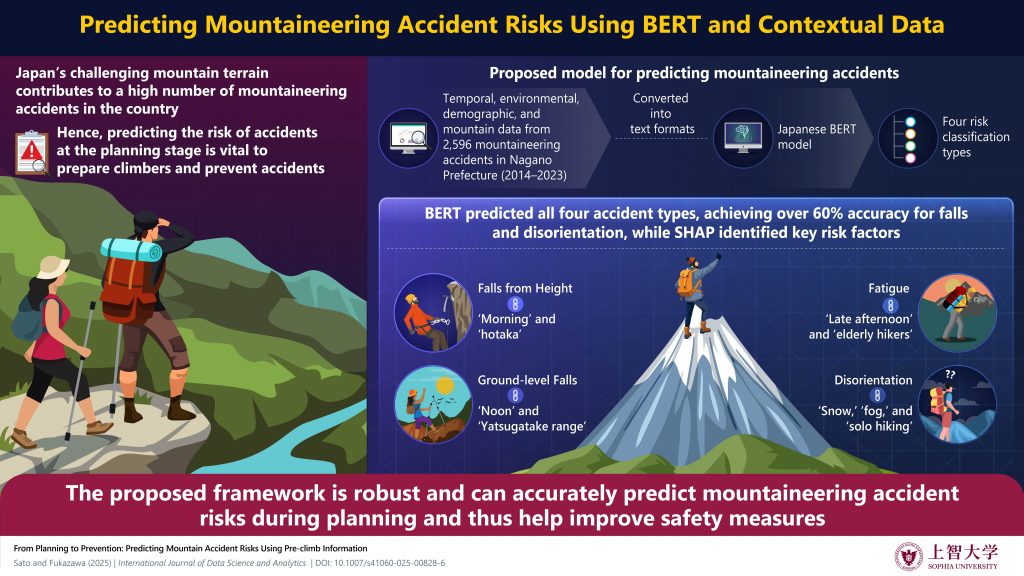Plan, Prepare, Conquer: Predicting Mountain Accident Risks with Deep Learning and Pre-climb Data

Researchers develop a robust framework using deep learning and contextual data to accurately predict mountaineering accident risks in advance
While Japan is renowned among mountaineers for its challenging mountain terrain, it is also known for its high number of mountaineering accidents.
Therefore, researchers developed a deep learning model that uses contextual information such as time of day, weather, mountain characteristics, and climbers’ details to accurately identify and predict four major categories of climbing accidents. This enables climbers and rescue teams to be better informed and prepared with safety measures at the planning stage.
Japan is famous for its beautiful mountain landscapes as well as for the challenges it offers to avid mountaineers. However, these mountains can get so treacherous that Japan actually records one of the highest numbers of mountain accidents globally. In fact, Japan had 3,126 mountain accidents in 2023, the highest annual total since 1961.
In particular, Nagano Prefecture, which has many mountains popular among climbers, is one of the regions with a high number of mountaineering accidents due to its rugged terrain and severe weather conditions.
Therefore, there is a dire need to accurately predict mountaineering accidents and estimate the risks in advance. This could help climbers and rescue teams prepare better while reducing the likelihood of future accidents.
While traditional machine learning has proven effective in predicting traffic accidents and natural disasters, its application to mountain accident prediction is limited by several factors: small datasets, the complex nature of accidents, and missing variables of environmental conditions and demographics.
To address this issue, Associate Professor Yusuke Fukazawa, together with graduate student Taeko Sato—both affiliated with the Graduate Program in Applied Data Sciences at Sophia University, Japan—developed a predictive model to assess mountaineering accident risks during the expedition planning stage. “Mountain accidents fall into four major categories: falls from height, ground-level falls, fatigue, and disorientation. However, these do not occur under uniform conditions; rather, they are closely related to factors such as time of day, terrain, weather conditions, and climber demographics,” explains Dr. Fukazawa.
Accordingly, they trained BERT, a deep learning model, with such contextual data to enable it to classify accident risks into the four key categories using climb-related information at the time of planning. The dataset consisted of 2,596 mountaineering accidents that occurred between 2014 and 2023 in the Nagano Prefecture. Furthermore, the researchers used SHAP analysis, an explainable AI technique, to visualize the relationships between the input features and predicted risks for each of the four accident categories. The results of this entire endeavor were published online in the International Journal of Data Science and Analytics on June 16, 2025.
The dataset had a stable number of annual accidents, with a notable decline only in 2020 due to the COVID-19 pandemic. However, there were distinct seasonal, temporal, and demographic patterns observed. For instance, more accidents were recorded during summer months, on weekends, and in the afternoon. Similarly, ground-level falls mainly occurred among women, whereas higher incidents of falls from height and disorientation were observed in men. Falls from height accounted for the greatest number of accidents, followed by ground-level falls, fatigue, and disorientation.
The BERT model accurately identified and predicted the four accident categories with over 60% accuracy achieved for two types: fall from height and disorientation. The SHAP analysis further aided in interpreting the model’s prediction to successfully classify the key predictors contributing to each category’s risk. Time of day, mountain location, weather conditions, and demographic factors were found to be critical predictors for all four categories. For example, “morning” and “Hotaka” were identified as strong predictors of falls from height, while “noon” and “Yatsugatake range” were for ground-level falls. Fatigue was linked to elderly climbers and the afternoon period, and disorientation was associated with conditions like snow and fog, as well as solo hiking. This matched with the patterns observed in the input dataset, which confirmed the robustness of the model.
“Our high-accuracy, multi-class predictive model provides climbers a better understanding of the specific risks associated with their planned actions and conditions, enabling safer decision-making and preparation. By tailoring risk assessments to each climber’s unique situation, our model offers personalized safety recommendations, a more practical and effective form of mountaineering support instead of the traditional, one-size-fits-all warnings,” says Dr. Fukazawa. “We also believe that our research can be used for developing mobile applications and web-based services that offer planning and safety solutions at people’s fingertips. This way we hope to improve risk management not only for mountaineering but also for other outdoor activities and encourage more people to step outside and safely enjoy nature.”
Interestingly, these results highlight the power of deep learning and explainable AI in making risk assessments more reliable. In fact, this approach has the potential to extend beyond mountaineering, with potential applications in other domains where AI-driven decision support can aid in risk prediction and safety planning.
Reference
- Title of original paper
From planning to prevention: predicting mountain accident risks using pre-climb information
- Journal
International Journal of Data Science and Analytics
- Authors
Taeko Sato and Yusuke Fukazawa
- Affiliations
Graduate Degree Program of Applied Data Sciences, Sophia University, Japan
About Dr. Yusuke Fukazawa
Yusuke Fukazawa is an Associate Professor at the Graduate Degree Program of Applied Data Sciences at Sophia University, Japan. His research focuses on machine learning, supervised learning, and predictive modeling and analytics. He completed his PhD from the Department of Precision Mechanical Engineering, The University of Tokyo. Prior to joining Sophia University, Dr. Fukazawa was a Senior Manager at NTT Docomo, Inc., and a visiting researcher at the University of Tokyo. He has 93 published articles and 274 industrial patents to his name, with 10 awards bestowed upon him for his research and student mentorship.
Media Contact
Office of Public Relations, Sophia University
sophiapr-co@sophia.ac.jp